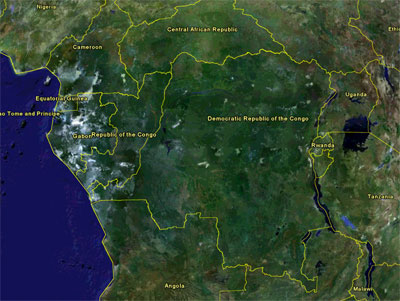CENTRAL AFRICAN REPUBLIC
Please note, this page is not longer being updated. For more recent information, please see news.mongabay.com and use the search function to find the country feed. For more up-to-date data on forest cover and loss, check out Global Forest Watch.
| Central African Republic Forest Figures
Forest Cover Total forest area: 22,755,000 ha % of land area: 36.5% Primary forest cover: n/a % of land area: n/a % total forest area: n/a Deforestation Rates, 2000-2005 Annual change in forest cover: -29,600 ha Annual deforestation rate: -0.1% Change in defor. rate since '90s: n/a Total forest loss since 1990: -448,000 ha Total forest loss since 1990:-1.9% Primary or "Old-growth" forests Annual loss of primary forests: n/a Annual deforestation rate: n/a Change in deforestation rate since '90s: n/a Primary forest loss since 1990: n/a Primary forest loss since 1990:n/a Forest Classification Public: n/a Private: n/a Other: n/a Use Production: 21.2% Protection: n/a Conservation: 78.8% Social services: n/a Multiple purpose: n/a None or unknown: n/a Forest Area Breakdown Total area: 22,755,000 ha Primary: n/a Modified natural: 22,750,000 ha Semi-natural: n/a Production plantation: 5,000 ha Production plantation: n/a Plantations Plantations, 2005: 5,000 ha % of total forest cover: n.s.% Annual change rate (00-05): 200,000 ha Carbon storage Above-ground biomass: 4,519 M t Below-ground biomass: 1,085 M t Area annually affected by Fire: n/a Insects: n/a Diseases: n/a Number of tree species in IUCN red list Number of native tree species: n/a Critically endangered: 0 Endangered: 1 Vulnerable: 8 Wood removal 2005 Industrial roundwood: 1,108,000 m3 o.b. Wood fuel: 2,458,000 m3 o.b. Value of forest products, 2005 Industrial roundwood: n/a Wood fuel: n/a Non-wood forest products (NWFPs): n/a Total Value: n/a More forest statistics for Central African Republic |
Subsistence agriculture, diamond mining, and forestry form the bulk of the economy of the Central African Republic. Burdened with poor infrastructure and high transportation costs, a largely unskilled work force, and poor economic policies, the Central African Republic is not a particularly attractive source for timber among African producers. Nevertheless, most of the country's forests have been logged for valuable tree species including sapelli, ayous and sipo. Most wood from the Central African Republic is exported to Europe.
Logging roads have opened up much of the Central African Republic to subsistence agriculture and poachers. Bushmeat hunting—some of the most severe in Africa—has taken a heavy toll on the country's once abundant and diverse wildlife. The black rhino is no longer present in the country due to poaching. Fuelwood collection has also put pressure on the Central African Republic's forests.
Deforestation and poor agricultural practices are resulting in desertification in the northern parts of the country.
The Central African Republic had one of the lowest total deforestation rates among tropical countries between 1990 and 2005 when just 1.9 percent of its forests were lost. However, the country's forest degradation rate was considerably higher due to logging.
Today about 16.6 percent of the Central African Republic is under some form of protection, though institutional support for protected areas has historically been weak, and hunters and loggers have continued to operate in national parks. The Central African Republic is home to about 3,600 species of plants, 663 birds, 131 mammals, 187 reptiles, and 29 amphibians.
Recent articles | Central African Republic news updates | XML
Suggested reading - Books
Unless otherwise specified, this article was written by Rhett A. Butler [Bibliographic citation for this page]
Other resources
Contact me if you have suggestions on other rainforest-related environmental sites and resources for this country.

Image copyright Google Earth, MDA EarthSet, DigitalGlobe 2005
CIA-World Factbook Profile
FAO-Forestry Profile
World Resources Institute
Last updated: 4 Feb 2006
